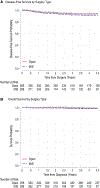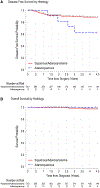Open vs minimally invasive radical trachelectomy in early-stage cervical cancer: International Radical Trachelectomy Assessment Study
- PMID: 34461074
- PMCID: PMC9518841
- DOI: 10.1016/j.ajog.2021.08.029
Open vs minimally invasive radical trachelectomy in early-stage cervical cancer: International Radical Trachelectomy Assessment Study
Abstract
Background: Minimally invasive radical trachelectomy has emerged as an alternative to open radical hysterectomy for patients with early-stage cervical cancer desiring future fertility. Recent data suggest worse oncologic outcomes after minimally invasive radical hysterectomy than after open radical hysterectomy in stage I cervical cancer.
Objective: We aimed to compare 4.5-year disease-free survival after open vs minimally invasive radical trachelectomy.
Study design: This was a collaborative, international retrospective study (International Radical Trachelectomy Assessment Study) of patients treated during 2005-2017 at 18 centers in 12 countries. Eligible patients had squamous carcinoma, adenocarcinoma, or adenosquamous carcinoma; had a preoperative tumor size of ≤2 cm; and underwent open or minimally invasive (robotic or laparoscopic) radical trachelectomy with nodal assessment (pelvic lymphadenectomy and/or sentinel lymph node biopsy). The exclusion criteria included neoadjuvant chemotherapy or preoperative pelvic radiotherapy, previous lymphadenectomy or pelvic retroperitoneal surgery, pregnancy, stage IA1 disease with lymphovascular space invasion, aborted trachelectomy (conversion to radical hysterectomy), or vaginal approach. Surgical approach, indication, and adjuvant therapy regimen were at the discretion of the treating institution. A total of 715 patients were entered into the study database. However, 69 patients were excluded, leaving 646 in the analysis. Endpoints were the 4.5-year disease-free survival rate (primary), 4.5-year overall survival rate (secondary), and recurrence rate (secondary). Kaplan-Meier methods were used to estimate disease-free survival and overall survival. A post hoc weighted analysis was performed, comparing the recurrence rates between surgical approaches, with open surgery being considered as standard and minimally invasive surgery as experimental.
Results: Of 646 patients, 358 underwent open surgery, and 288 underwent minimally invasive surgery. The median (range) patient age was 32 (20-42) years for open surgery vs 31 (18-45) years for minimally invasive surgery (P=.11). Median (range) pathologic tumor size was 15 (0-31) mm for open surgery and 12 (0.8-40) mm for minimally invasive surgery (P=.33). The rates of pelvic nodal involvement were 5.3% (19 of 358 patients) for open surgery and 4.9% (14 of 288 patients) for minimally invasive surgery (P=.81). Median (range) follow-up time was 5.5 (0.20-16.70) years for open surgery and 3.1 years (0.02-11.10) years for minimally invasive surgery (P<.001). At 4.5 years, 17 of 358 patients (4.7%) with open surgery and 18 of 288 patients (6.2%) with minimally invasive surgery had recurrence (P=.40). The 4.5-year disease-free survival rates were 94.3% (95% confidence interval, 91.6-97.0) for open surgery and 91.5% (95% confidence interval, 87.6-95.6) for minimally invasive surgery (log-rank P=.37). Post hoc propensity score analysis of recurrence risk showed no difference between surgical approaches (P=.42). At 4.5 years, there were 6 disease-related deaths (open surgery, 3; minimally invasive surgery, 3) (log-rank P=.49). The 4.5-year overall survival rates were 99.2% (95% confidence interval, 97.6-99.7) for open surgery and 99.0% (95% confidence interval, 79.0-99.8) for minimally invasive surgery.
Conclusion: The 4.5-year disease-free survival rates did not differ between open radical trachelectomy and minimally invasive radical trachelectomy. However, recurrence rates in each group were low. Ongoing prospective studies of conservative management of early-stage cervical cancer may help guide future management.
Keywords: disease-free survival; fertility; hysterectomy; laparoscopy; minimally invasive surgical procedures; recurrence; retrospective studies; robotic surgical procedures; trachelectomy; uterine cervical neoplasms.
Copyright © 2021 Elsevier Inc. All rights reserved.
Conflict of interest statement
M.M.L. performs ad hoc consulting or speaking for Intuitive Surgical and serves on the advisory boards of Ethicon, Medtronic, and Takeda. H.F. has received honoraria for proctoring and money for educational lectures from Intuitive Surgical. J.P. has received honoraria for lectures and proctoring from Intuitive Surgical. M.V. has received honoraria for lectures from Johnson & Johnson (J&J). C.F. has received honoraria for advisory board service from Tesaro, GlaxoSmithKline, Clovis, Merck Sharp & Dohme (MSD) and AstraZeneca (AZ), Ethicon, Sequana, and Roche. A.T. has received honoraria for educational lectures and advisory board service from Roche, AZ, MSD, and J&J. The remaining authors report no conflict of interest.
Figures




References
-
- National Comprehensive Cancer Network. NCCN Clinical practice guidelines in oncology (NCCN guidelines). 2021. Available at: https://www.nccn.org/professionals/physician_gls/pdf/cervical.pdf. Accessed March 5, 2021. - PubMed
-
- Ramirez PT, Frumovitz M, Pareja R, et al. Minimally invasive versus abdominal radical hysterectomy for cervical cancer. N Engl J Med 2018;379:1895–904. - PubMed

